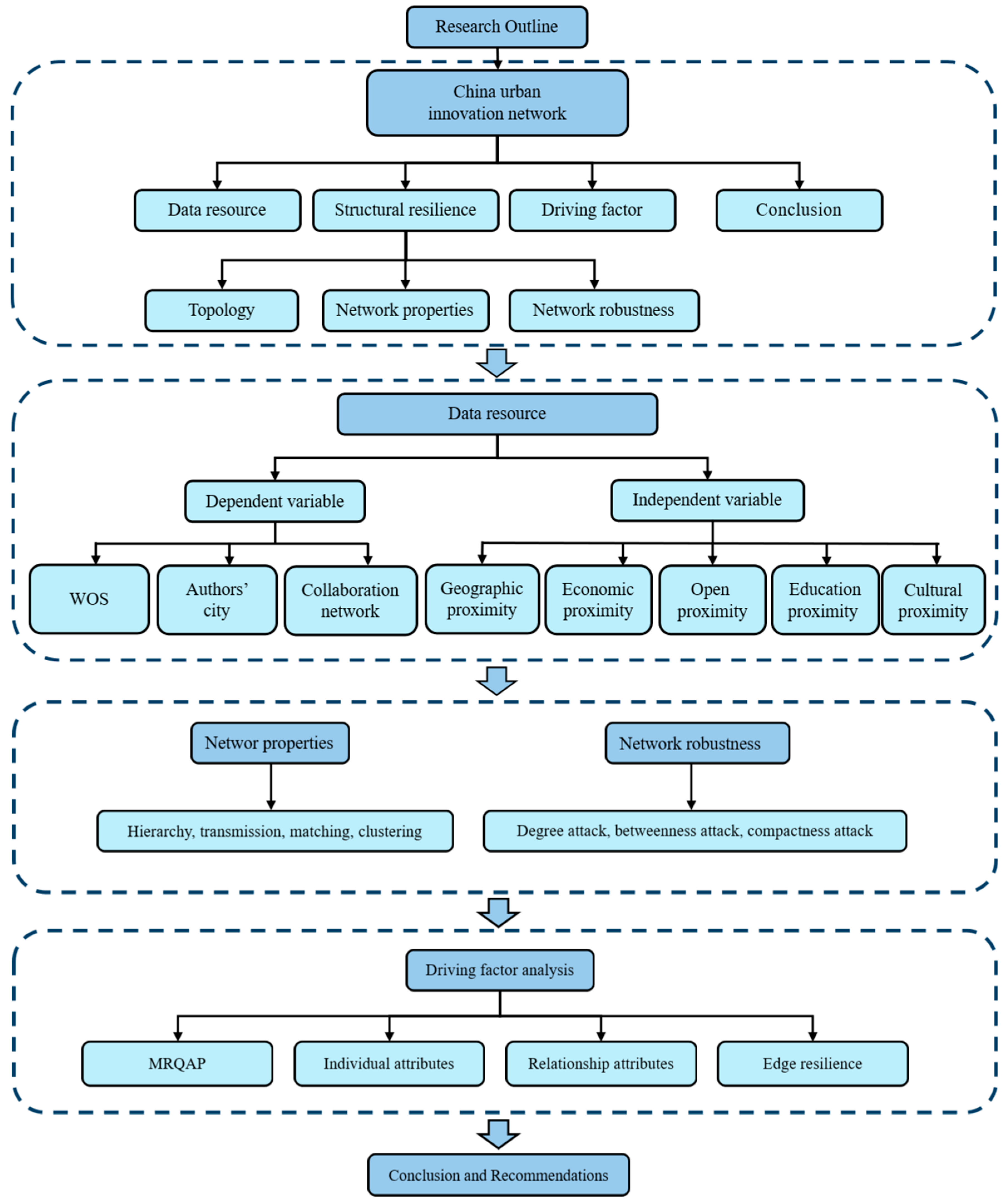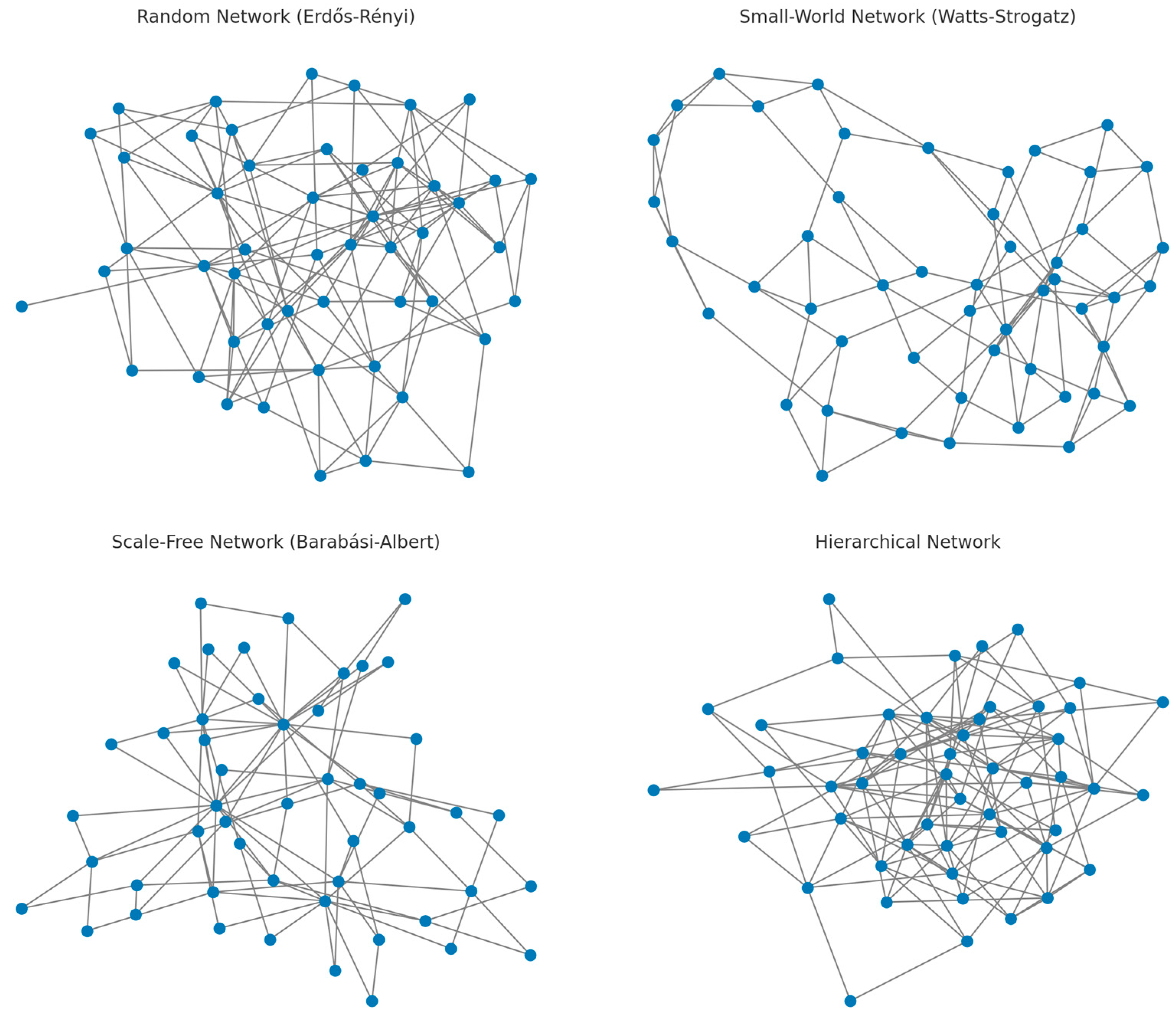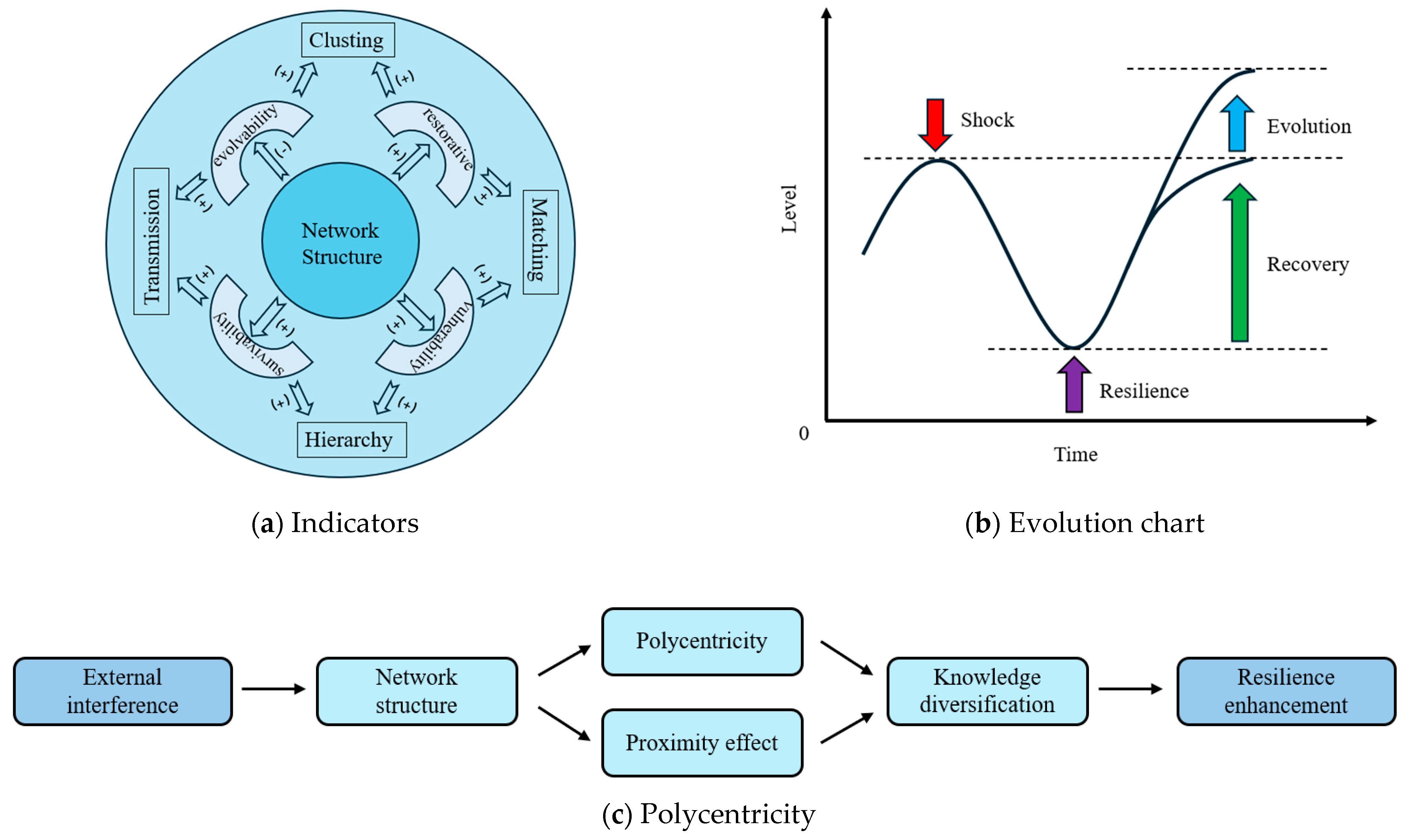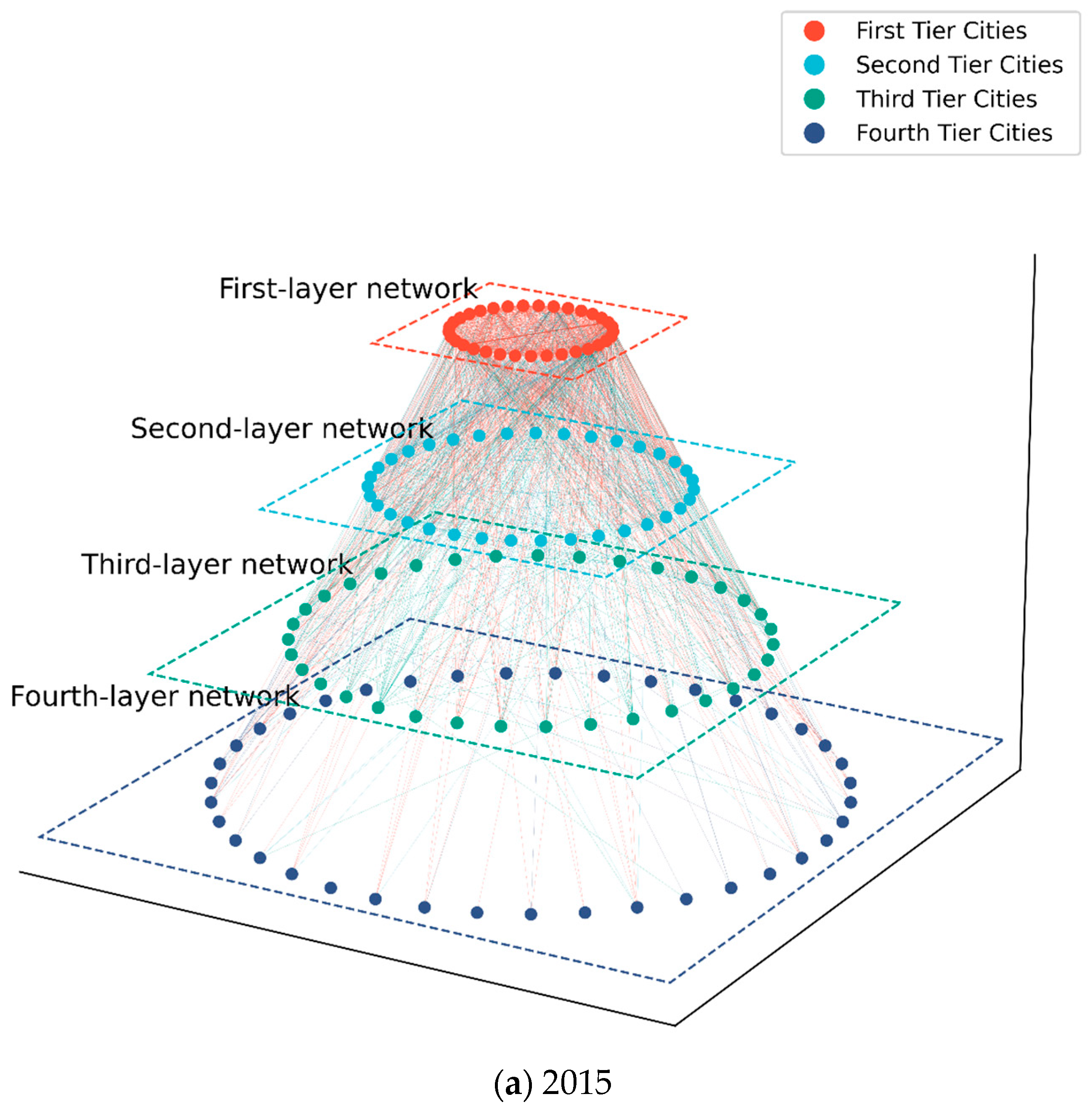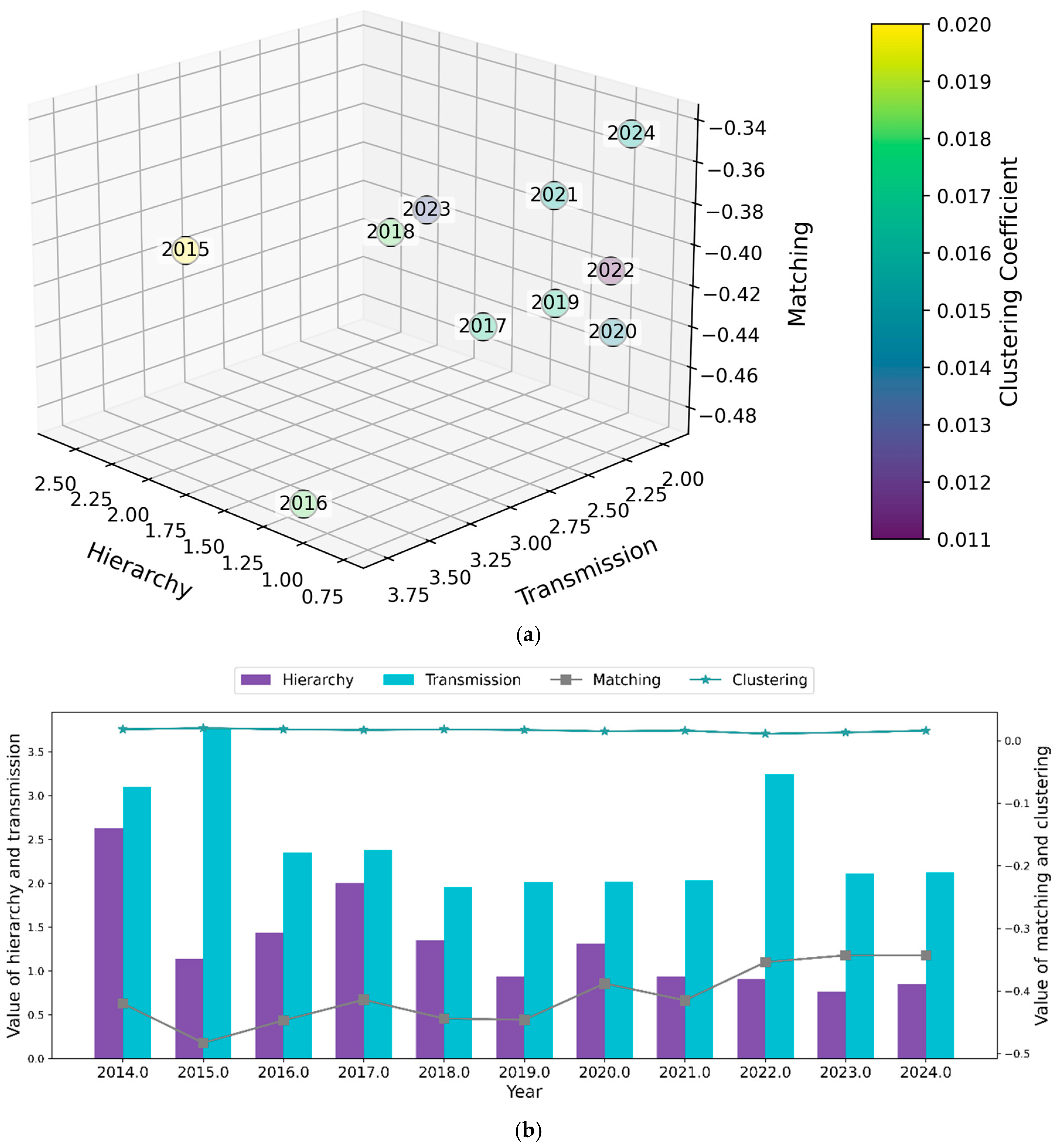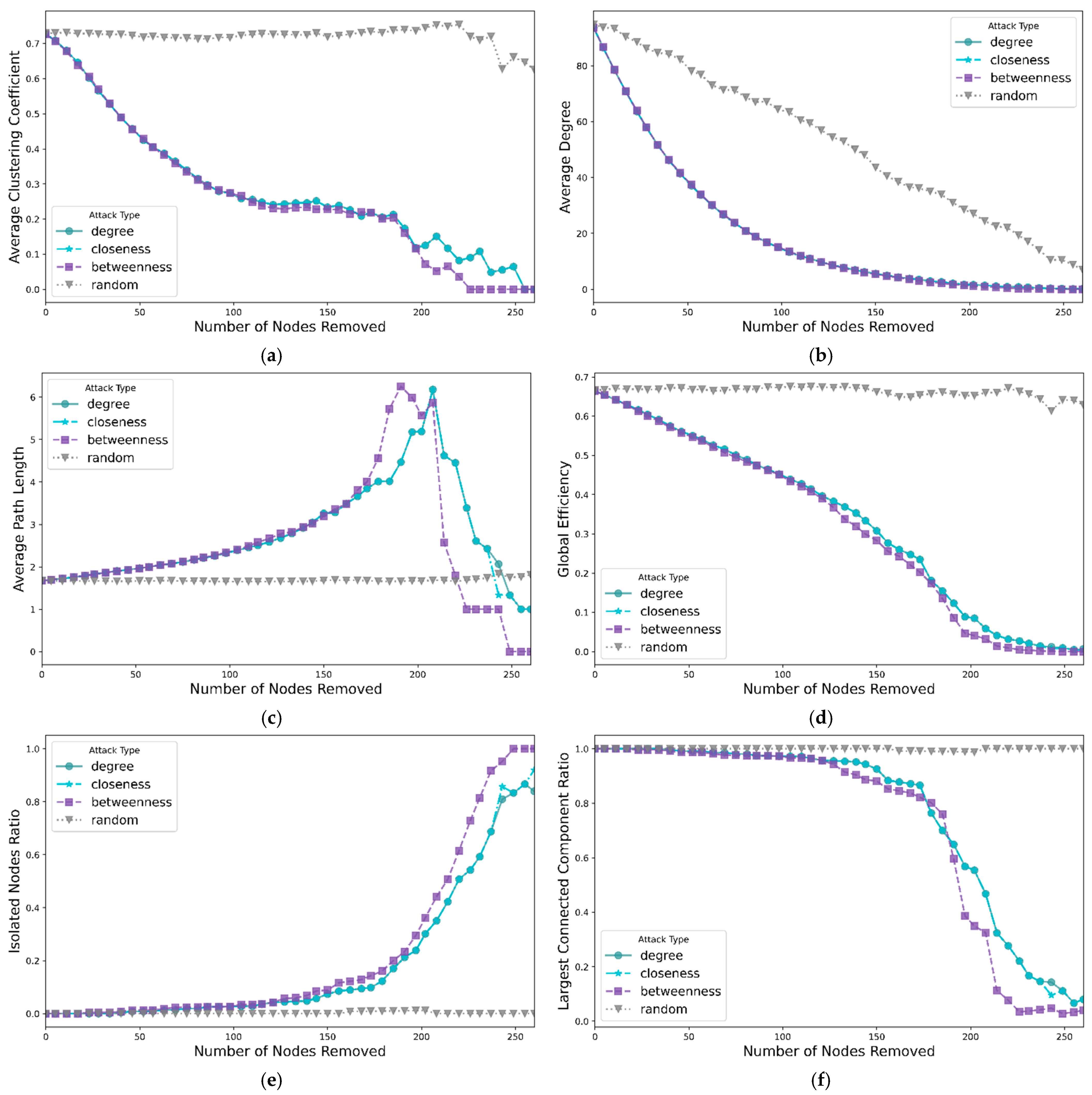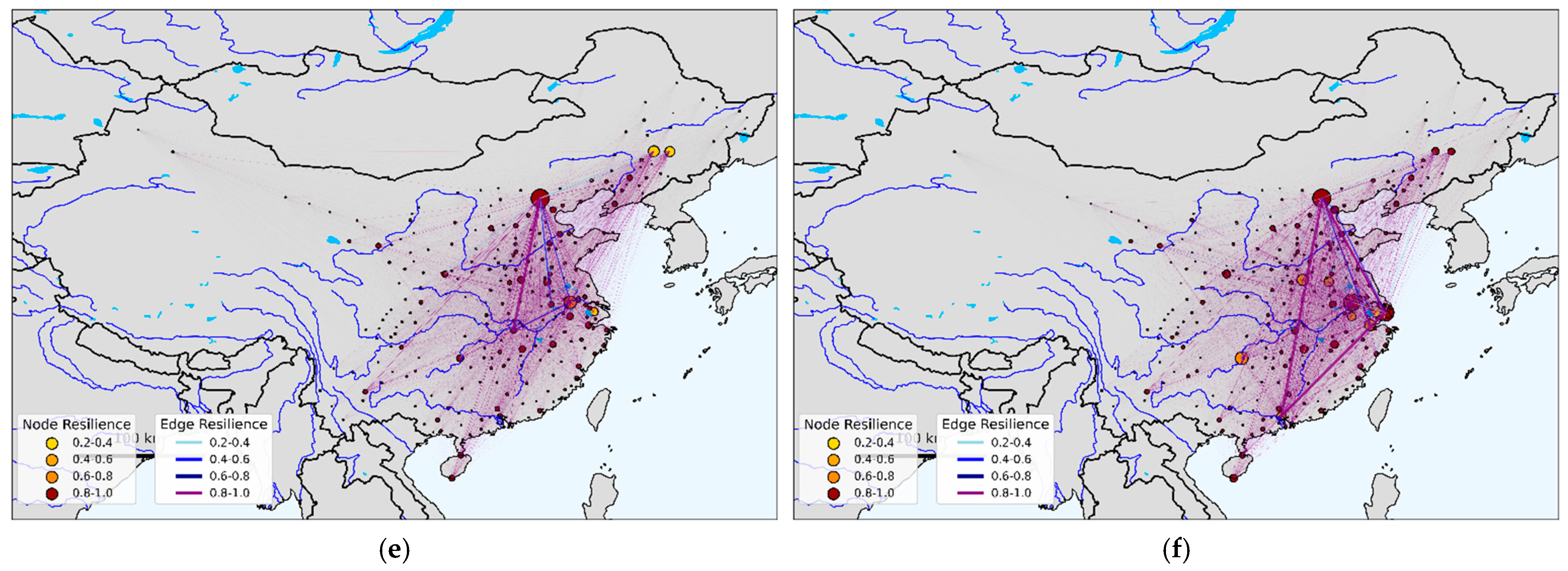1. Introduction
The spatial organization of knowledge and innovation networks has become a key determinant of regional competitiveness in the era of globalization. While the existing literature has extensively explored innovation networks in developed economies, significant gaps remain in understanding the evolutionary dynamics and structural resilience of such networks in emerging economies like China, a country undergoing rapid urbanization and innovation-driven transformation with unique spatial–economic disparities [
1,
2,
3]. Traditional studies focusing on static network structures or unidimensional proximity mechanisms (e.g., geographic or institutional) have systematically neglected two critical aspects: (1) dynamic interactions among multiple proximity dimensions, and (2) systemic vulnerabilities arising from China’s distinct “core-periphery” polarization observed in innovation ecosystems. This oversight limits our understanding of network adaptation mechanisms in transitional economies.
Recent advances in network science methodology have revealed new complexities in the analysis of innovation systems. While traditional QAP methods are effective in detecting patterns of correlation, they are unable to account for multivariate interactions during network evolution, a critical limitation that is addressed by our application of the Multivariate Regression Quadratic Assignment Procedure (MRQAP) [
4,
5]. Building on the analysis from this, we develop a novel four-dimensional framework integrating the following: (1) the spatio-temporal dynamics of knowledge diffusion, (2) topological evolution patterns, (3) structural resilience assessment, and (4) proximity mechanism interactions. This integrated approach overcomes three persistent research limitations: the temporal nonlinearity blind spot in network integration, inadequate vulnerability assessment under targeted attacks, and oversimplified proximity interaction models [
6].
Our analysis of SCI/SSCI co-authorship networks (2014–2024) reveals three transformative trends reshaping China’s innovation geography. First, the post-2015 surge in network density and localized clustering (peaking in 2021–2022) initially reinforced the observed core–periphery integration, but subsequent structural divergence (post-2022) exposed previously underestimated vulnerabilities in knowledge flow sustainability. Second, interdegree centrality emerges as both the most critical and vulnerable network attribute, highlighting the urgent need for polycentric resilience strategies to mitigate overdependence on megacity hubs like Beijing and Shanghai. Third, our temporal analysis reveals a paradigm shift in proximity effects: while economic proximity’s inhibiting effect significantly weakens by 2024, new synergies emerge between geographic and economic proximity dimensions, suggesting evolving spatial–economic coordination mechanisms.
In recent years, the dynamic evolution of China’s urban knowledge and innovation network and its profound impact on the economy and society have garnered significant academic attention. This network’s development has been driven by innovation-driven policies and industrial upgrading strategies [
7], as well as by the accelerated flow of knowledge, talent, and technology, which has reshaped regional collaborative development patterns [
8,
9]. The rise of large urban agglomerations and regional central cities has further facilitated the construction of a multi-level knowledge-sharing system. This system is characterized by enhanced connectivity strength, network density, and node centrality, offering rich research scenarios for social network analysis and geospatial studies [
10].
While these structural analyses provide important insights, recent methodological innovations have begun quantifying policy intervention effects through computational modeling. Specifically, some scholar developed an agent-based model to simulate how Smart Specialization policies can optimize inter-regional knowledge network formation, addressing critical prioritization challenges in regional development [
11]. This computational approach complements our MRQAP-based framework by enabling counterfactual policy evaluation—a crucial capacity for evidence-based policymaking in transitional economies.
The integration of social network analysis and geographic information systems provides a robust methodological framework for examining interactions among urban nodes. Research indicates that core cities, leveraging their resource agglomeration advantages, play a pivotal role in knowledge integration and diffusion [
12]. However, this centrality often exacerbates network asymmetries [
13]. To address this, second-tier cities and emerging innovation hubs are actively engaging with core nodes to increase their network connection weight. Such collaborations have not only spurred cross-regional projects but also fostered the development of polycentric network structures. Some regions exhibit characteristics of small-world networks [
14], where local high-density connectivity coexists with efficient cross-regional information transfer. This structure is believed to balance innovation collaboration costs with network stability [
15].
Network resilience to external shocks and internal node failures has emerged as a critical indicator of sustainability. Studies reveal that a center-edge structure, overly reliant on a few core nodes, is susceptible to systemic risks. In contrast, redundant connections and decentralized layouts significantly enhance network resilience [
16,
17,
18]. For instance, the COVID-19 pandemic and supply chain crises highlighted the vulnerabilities of single-connectivity models, while cities with multi-channel connectivity and local innovation capabilities demonstrated greater resilience [
19,
20,
21,
22]. Consequently, fostering multiple regional innovation centers and enhancing functional substitutability among nodes have become key strategies for optimizing network resilience. This approach must balance the functional relief of core cities with the innovation empowerment of small and medium-sized cities to prevent resource concentration-induced path dependence [
23].
The topology of China’s urban knowledge and innovation network is characterized by the complexity of core-edge and multi-layer nesting structures. On the one hand, high-centrality nodes dominate knowledge flows, creating a hierarchical distribution. On the other hand, small-world networks and scale-free networks within certain regions maintain local collaboration efficiency while achieving global resource integration through cross-layer connections. However, this structure may also lead to knowledge locking effects, hindering cross-regional transfer. To address this, scholars have proposed introducing bridging nodes to activate weak connections and constructing cross-layer knowledge reuse mechanisms. These strategies aim to enhance the flexibility and adaptability of the network structure, thereby breaking through innovation path dependency [
24,
25].
The evolution of knowledge networks is underpinned by geographic, cultural, institutional, and economic proximity. Traditionally, geographic proximity has facilitated cooperation by reducing transaction costs. However, with the proliferation of digital infrastructure, soft proximity factors such as cultural identity, institutional compatibility, and economic complementarity are becoming increasing importance [
26,
27]. For instance, the Guangdong–Hong Kong–Macao Greater Bay Area has achieved a high level of integration between Shenzhen and Hong Kong through institutional synergy and industrial complementarity. Additionally, the educational environment exerts a long-term influence on city network dynamics: high-level universities and research platforms not only enhance local knowledge output but also attract external talent, thereby strengthening node connectivity [
28]. Furthermore, changes in the external environment such as international scientific competition and value chain restructuring require the upgrading of the network’s internal synergistic mechanisms, fostering the development of independent innovation capacity.
This study makes four key theoretical contributions: (1) advancing networked geo-economy theory through dynamic proximity analysis in emerging economies, (2) developing a resilience assessment framework for innovation systems under disruption scenarios, (3) demonstrating polycentric governance’s potential for simultaneous efficiency–sustainability optimization, and (4) establishing a transferable methodological framework that can be readily applied to analyze similar knowledge networks in other contexts, particularly offering new analytical tools for European and Latin American innovation system studies.
The methodological framework developed in this study holds significant potential for application in European and Latin American contexts, where knowledge networks face similar challenges of balancing efficiency and resilience amid regional disparities. Our center-based modeling approach, combined with dynamic proximity analysis, provides a robust tool for examining how different governance structures and spatial configurations influence innovation system performance across varying institutional environments. Particularly for Europe’s highly integrated but unevenly developed innovation networks and Latin America’s emerging yet fragmented knowledge systems, our resilience assessment metrics offer comparable indicators to evaluate network vulnerabilities to targeted disruptions. The polycentric governance insights derived from China’s experience may inform policy discussions in these regions, especially regarding inter-regional knowledge diffusion and adaptive capacity building. By applying this framework to comparative studies, researchers could uncover both universal principles of innovation network resilience and context-specific adaptation strategies, thereby enriching the global understanding of how geographical and institutional factors interact to shape knowledge creation and diffusion patterns.
Practically, our findings provide policymakers with actionable strategies to optimize China’s “East Cluster, West Sparse” innovation pattern through the following: inter-regional knowledge corridor development, adaptive proximity mechanism utilization, and polycentric node cultivation. These insights offer valuable references for countries in the Global South pursuing similar innovation-driven development trajectories.
This study proposes two hypotheses:
H1: Geographic proximity and economic proximity have complementary effects on KINs.
H2: The interaction effect between geographic and economic proximity has intensified over the past decade.
3. Empirical Analysis
3.1. KIN Analysis
The hierarchical transformation of China’s KIN between 2015 and 2024, as visualized in
Figure 4a,b, vividly demonstrates the network’s journey through the resilience phases shown in
Figure 3b. The 2015 configuration’s fragmented structure, with its weak core–periphery connections, exemplified the vulnerability stage in the resilience curve, corresponding to low clustering and transmission metrics in
Figure 3a. By 2024, the network’s evolution into a stable hierarchy with strengthened Tier 1 hubs and robust inter-tier connections marked its successful transition through recovery to the evolution phase, evidenced by improved matching and hierarchy indicators.
This structural progression perfectly mirrors the theoretical resilience framework, where the network’s ability to reorganize beyond its initial state is demonstrated through enhanced transmission pathways and clustering patterns. The visual contrast between the early vulnerable configuration and the later evolved structure provides empirical validation for the system’s capacity to absorb shocks and achieve greater stability, as predicted by the network structure characteristics mapped in
Figure 3a and the phase transitions diagrammed in
Figure 3b.
Figure 5 illustrates the temporal evolution of node and edge resilience. In 2014, the network exhibited a core–periphery structure with low density and fragmented links, heavily reliant on a few core cities like Beijing, Shanghai, and Guangzhou. Over the next decade, connectivity improved significantly, transforming the network into a multi-center, multi-level system. This shift was driven by national policies such as the National New Urbanization Plan and the 13th Five-Year Plan for Scientific and Technological Innovation, which promoted balanced regional development and inter-city knowledge sharing. Infrastructure projects like the high-speed rail expansion and initiatives such as the Beijing–Tianjin–Hebei Coordinated Development Strategy further strengthened edge resilience by facilitating faster and more frequent collaboration between core and peripheral cities.
Despite these advancements, regional disparities persist. While eastern hubs like the Yangtze River Delta and Greater Bay Area benefit from well-established policies like the Regional Integration Development Plans, western and northeastern cities face slower progress due to weaker institutional support and fewer resource-sharing mechanisms. Recent strategies such as the Western Development Revitalization Plan and the 14th Five-Year Plan’s emphasis on multi-polar innovation nodes aim to address these gaps by fostering emerging hubs like Chengdu, Wuhan, and Xi’an. However, the network’s edge resilience remains uneven, highlighting the need for more targeted policy interventions to ensure long-term stability and equitable knowledge diffusion across all regions.
These resilience patterns align with recent findings on organizational adaptation to external disruptions. As some scholar demonstrated through a longitudinal analysis of U.S. knowledge-intensive organizations, when entities fail to meet historical or social aspiration levels (e.g., during COVID-19 disruptions), they actively diversify technological knowledge repositories—a behavior moderated by their existing knowledge footprint [
37]. This mechanism provides a micro-foundational explanation for our observed macro-level network transformations: (1) the declining hierarchy reflects decentralized knowledge diversification strategies, (2) stable clustering suggests path-dependent adaptation constrained by regional knowledge footprints, and (3) emerging cities’ edge strength growth manifests as collective responses to unmet innovation aspirations.
The kernel density estimation (KDE) plots in
Figure 6 were generated using a Gaussian kernel smoothing technique to visualize the probability density distribution of resilience contribution values. The implementation utilizes Python’s Seaborn library with key parameters including a bandwidth adjustment factor (bw_adjust = 0.5) to control the smoothness of the density curves. The
x-axis represents normalized contribution values ranging from 0 to 1, where higher values indicate greater resilience contributions from network elements. The
y-axis shows the estimated probability density, with the area under each curve integrating to unity. The plots employ a fill transparency (alpha = 0.8) to enhance visual clarity while maintaining the visibility of grid lines and background elements. For temporal comparison, identical axis scales and plot dimensions were maintained across all years (2015–2024), with node resilience shown in gray (#808080) and edge resilience in teal (#5F9EA0) to facilitate immediate visual distinction between the two network components. The density curves effectively capture both the central tendencies and dispersion characteristics of resilience contributions for each year.
The kernel density plots reveal distinct patterns in the evolution of network resilience characteristics from 2015 to 2024. For node resilience, the gray-colored distributions consistently exhibit a right-skewed unimodal shape across all years, with peak densities concentrated in the lower contribution range (0.2–0.4) and gradually tapering off towards higher values. This persistent pattern suggests that most nodes in the network consistently provide moderate resilience contributions, with relatively few nodes offering either very low or very high contributions. The stability of these distributions over time indicates that the fundamental role distribution of nodes in maintaining network resilience remained largely unchanged throughout the decade, despite potential changes in network size or structure.
The teal-colored edge resilience distributions show more pronounced temporal variations while maintaining their characteristic single-peaked form. The early years (2015–2017) displayed broader distributions with flatter peaks, suggesting greater variability in edge contributions during this period. As time progressed, the distributions became progressively more concentrated, with the later years (2020–2024) showing sharper peaks and narrower ranges. This evolution implies that the network’s edge resilience mechanisms became more standardized and efficient over time, with edges increasingly clustered around optimal contribution levels. The leftward shift in peak positions indicates that the network gradually adapted to achieve sufficient resilience with lower individual edge contributions.
3.2. Network Resilience
In this study, we calculate the overall network density of China’s urban networks and examine the structural changes in four network types, business flow, knowledge flow, education flow, and economy flow, across different time dimensions (2014–2024). To more accurately capture the characteristics of urban networks, this study departs from traditional binary classifications and instead adopts an innovative three-valued classification method. Given the significant variation in data sources, we differentiate between the core network and general network to distinguish urban connections of varying strengths. The results are presented in
Table 3 below.
Based on multi-dimensional data from China’s urban KIN, this study examines changes in the network density of different innovation elements, including business flows, knowledge flows, education flows, and economy flows, among cities between 2014 and 2024. Overall, the network density of each type of flow exhibits an upward trend; however, significant differences exist in the diffusion patterns of various innovation factors, reflecting the heterogeneity among cities in terms of foreign capital inflows, knowledge spillovers, science and education collaboration, and economic linkages.
The core network density of business flows fluctuates within a narrow range of 0.140 to 0.147, indicating that multinational investment remains concentrated in a few core cities. Meanwhile, the rising density of general networks suggests that foreign investment is gradually diffusing to a broader range of cities. The steady increase in the core network density of knowledge flows implies that innovative knowledge is becoming more interconnected among core cities, while the rising density of general networks reflects the expansion of knowledge spillover effects, contributing to the overall enhancement of regional innovation capacity.
The core network density of education flows declines in certain years, indicating that higher education and research cooperation still primarily depend on a few core cities. In contrast, the relatively stable general network density suggests that the distribution pattern of science and education resources has not undergone significant changes. Conversely, the core network density of economy flows has increased from 0.059 to 0.081, signifying stronger economic linkages among innovation core cities. However, the limited change in general network density suggests that economic factor flows still heavily rely on core nodes and have yet to form extensive network synergies.
Overall, China’s urban KIN continues to develop, with more pronounced diffusion effects in foreign capital and knowledge flows, whereas science and education resources and economic linkages remain largely concentrated in core cities. This indicates that the agglomeration effect of the innovation network remains significant. Further optimization of resource allocation and the promotion of a more balanced flow of innovation factors will be essential for fostering the synergistic development of regional innovation.
Table 4 and
Figure 7 below illustrate the evolutionary characteristics of the network structure metrics. Both hierarchy and matching show the slope term. The primary coordinates of
Figure 7 are bar graphs and the secondary coordinates are line graphs.
The 3D scatter plot in
Figure 7a systematically visualizes the temporal evolution of three network metrics—hierarchy, transmission, and matching—from 2015 to 2024. Each data point, labeled with its respective year, occupies a position in the 3D space defined by these axes, while its color intensity (gradient: deep purple to bright yellow) quantitatively represents the clustering value, with darker hues indicating lower coefficients (e.g., 2022 at 0.011) and lighter tones denoting higher values (e.g., 2015 at 0.020).
The temporal evolution of the network metrics in
Table 4 reveals critical insights into China’s knowledge cooperation dynamics under external disruptions. The steady decline in hierarchy (from 2.627 in 2014 to 0.851 in 2024) signifies a structural shift toward polycentric governance, where knowledge authority becomes increasingly decentralized—a pattern corroborated by our conceptual model (
Figure 5c) showing how external shocks trigger network restructuring through polycentric adaptation. This aligns with some scholar’s micro-level findings that organizations diversify knowledge repositories when facing unmet innovation aspirations, as the flattening hierarchy reflects collective efforts to mitigate systemic vulnerabilities through broader participation.
Notably, the persistent negative matching coefficients (−0.420 to −0.343) and stable clustering (0.018–0.011) demonstrate path-dependent adaptation constrained by regional knowledge footprints, echoing the proximity effects in our model. While transmission efficiency fluctuates (peaking at 3.762 in 2015), its overall growth (2.125 in 2024 vs. 3.101 in 2014) suggests strengthened inter-city linkages—consistent with the knowledge diversification to resilience enhancement pathway visualized in
Figure 5c. These metrics collectively validate that China’s network resilience emerges from polycentric reorganization (reducing hierarchy) and localized learning (maintaining clustering), while spatial disparities in matching reflect uneven knowledge footprint effects.
This study identifies the following evolutionary characteristics based on the analysis of data from 2014 to 2024:
Declining hierarchy: The knowledge network has experienced a reduction in hierarchical structure. The hierarchy metric decreased from around 2.627 in 2014 to approximately 0.851 in 2024, suggesting a shift toward a more balanced and less centralized structure. Despite fluctuations in 2015 and 2017, the overall trend has remained downward, likely due to the decentralization of innovation resources and changes in the structure of knowledge dissemination.
Decline in transmission: The efficiency of knowledge flow has steadily declined. The transmission value decreased from 3.762 in 2015 to 2.125 in 2024, reflecting reduced accessibility and efficiency in knowledge dissemination.
Relatively stable matching: The alignment between innovation entities in the network has remained largely unchanged. The matching value slightly decreased from −0.420 in 2014 to −0.343 in 2024, suggesting only minor changes in the trend toward network homogenization. Despite this slight decline, network heterogeneity remains relatively stable, indicating that collaborative relationships among innovation entities have not undergone significant changes and that the network has maintained a balanced state.
Stable clustering: Regional innovation collaboration has remained largely stable. The clustering value decreased slightly from 0.018 in 2014 to 0.016 in 2024. While clustering showed slight increases in 2015 and 2021, the overall trend remained stable. This suggests that the existing infrastructure and policy support for regional collaborative innovation have remained effective. However, the future improvement of agglomeration effects may face new challenges, requiring sustained diversification and openness in innovation resources.
3.3. Network Vulnerability
In this study, we conducted the simulation using Python (3.11.7) and its NetworkX library. After 20 min of computation, the results of 2024 were obtained, as summarized in
Figure 8 below. Degree attacks represent connectivity loss, closeness attacks represent propagation delays, and betweenness attacks represent structural splitting.
Average clustering coefficient analysis: It can be observed that betweenness attack, closeness attack, and degree attack lead to a sharp decline in clustering, whereas random attack has a relatively minor effect. This suggests that nodes with high betweenness centrality or high closeness centrality play a crucial role in maintaining local structural cohesion. Since nodes with high betweenness centrality often act as bridges between multiple sub-networks, their removal disrupts local clustering, thereby reducing the network’s overall modularity. The closeness attack, however, follows a slightly different mechanism—by removing nodes with short average paths (which are typically located at the network core), the stability of local connectivity diminishes, leading to a weaker clustering structure. These findings highlight the importance of strengthening local clustering structures to enhance network resilience, ensuring that local connectivity remains robust even if core nodes are compromised.
Average degree analysis: Our findings indicate that all attack strategies lead to a decline in the network’s average degree, though the magnitude of impact varies by strategy. Degree attack, closeness attack, and betweenness attack cause a rapid decline in the average degree, as these strategies preferentially remove nodes with high connectivity or high betweenness centrality, significantly reducing the number of connections of the remaining nodes. In contrast, random attack has the least impact on the average degree, suggesting that randomly removing nodes fails to effectively disrupt key connectivity points, allowing the network to maintain a certain level of topology.
Average path length: As the number of node removals increases, attacks based on betweenness centrality cause a dramatic rise in the path length, suggesting that the removal of critical nodes has the most significant impact on network connectivity. Degree attacks also lead to a notable increase in path length, although the effect is somewhat less pronounced. In contrast, random attacks cause the smallest change, resulting in a more moderate increase in path length. These findings emphasize that node centrality is crucial for maintaining network efficiency.
Global efficiency analysis: Our results demonstrate that all attack strategies reduce global efficiency, with the betweenness attack having the most severe impact. Global efficiency measures the overall capability of information transfer within the network, and its decline signifies increased communication inefficiencies and reduced system responsiveness. In our experiments, the betweenness attack caused a rapid decay in global efficiency, while the degree attack had a slightly smaller but still significant effect on network communication. In contrast, random attacks exhibited the least impact, indicating that random node removal does not severely disrupt critical path structures. The closeness attack has a more complex influence, primarily fragmenting the core region, making the previously efficient communication network more decentralized. This result underscores the importance of identifying and protecting high betweenness centrality nodes as a defense strategy to maintain network efficiency and resilience against targeted attacks.
Maximum connectivity subgraph ratio: The proportion of the maximally connected subgraph provides further insights into network connectivity degradation under different attack strategies. Our analysis reveals that betweenness and closeness attacks rapidly reduce this ratio, while random attacks have the least effect. This suggests that nodes with high betweenness centrality serve as critical communication hubs, essential for maintaining the overall connectivity of the network. When these nodes are removed, the network fragments quickly into multiple smaller subgraphs, leading to significant connectivity loss. Degree attacks also weaken connectivity, particularly in networks with a high concentration of highly connected nodes. In contrast, the random attack causes a more gradual decline, implying that the network retains some adaptive capacity when faced with non-targeted disruptions. These findings highlight the importance of introducing redundant connections in network design to enhance structural robustness, ensuring the network remains stable even when critical nodes are removed.
Proportion of isolated nodes: As the number of removed nodes increases, the proportion of isolated nodes in the network gradually rises, with the most pronounced effects observed in betweenness attack and closeness attack. These two attack strategies prioritize the removal of nodes with high global or local centrality, causing a substantial number of dependent nodes to lose connectivity and become isolated. In contrast, degree attacks initially exhibit a slower impact on the growth of isolated nodes, as the removed high-degree nodes may still allow some low-degree nodes to remain connected via alternative paths. However, as the degree-based attack progresses, the growth rate of isolated nodes accelerates. On the other hand, random attacks, which do not specifically target critical nodes, result in a slower increase in isolated nodes, indicating that the network can maintain some level of connectivity under non-targeted attacks. This phenomenon further underscores the necessity of strengthening redundant connections in network design to ensure that even when critical nodes are removed, the remaining nodes retain a certain level of accessibility, thereby mitigating isolation and enhancing overall network resilience.
The results indicate that betweenness attacks are the most destructive, leading to the rapid deterioration of multiple network metrics. Through quantitative analysis, we identify that nodes with high degree centrality play a critical role in maintaining network stability, while closeness centrality also significantly impacts network connectivity in certain cases. The analytical results presented in this study provide a valuable reference for network optimization and defense strategy formulation. In particular, when designing defense mechanisms against targeted attacks, priority should be given to protecting these critical nodes to maintain network functionality and accessibility.
3.4. Driving Factors
Figure 9 presents the evolution of node resilience and edge resilience under different contextual factors; specifically, (a) and (b) represent the economic proximity, (c) and (d) correspond to the educational proximity, and (e) and (f) illustrate the opening proximity. Additionally,
Table 5 reports the MRQAP regression results obtained using UCINET 6.186 with 2000 permutations, a random number seed of 474, and significance values calculated using the permutation test.
Based on
Table 5, the economic proximity (eco), the educational proximity (edu), and the opening proximity (ope) exhibit significant changes in the structure of innovation cooperation networks between 2014 and 2024. While economic proximity exhibited a sparse network in 2014, with only a few core cities (e.g., Beijing and Shanghai) maintaining strong ties with other cities and an overall loose structure, the network density increased substantially in 2024, particularly in the eastern coastal region, indicating that the convergence of economic development has mitigated the barrier posed by economic disparity to innovation cooperation. The educational proximity exhibited a smaller-scale innovation cooperation network in 2014, with nodes and edges more decentralized; however, by 2024, the network expanded significantly, with closer ties established between cities with stronger higher education resources. This trend suggests that the increased influence of the educational environment on innovation cooperation may be linked to enhanced talent mobility, strengthened academic collaboration, and the greater sharing of research resources. In contrast, the opening proximity continued to play a facilitating role in 2014, but its influence was relatively limited and primarily concentrated in a few core cities. By 2024, its influence had diminished, with links weakening or even disappearing in certain regions, which may be attributed to policy adjustments, reduced reliance on foreign investment, or shifts in the international environment. Overall, these findings suggest that while economic and educational factors are increasingly driving innovation cooperation, external factors have become less influential over time.
From the regression analysis of
Table 5, the educational proximity and cultural proximity have consistently demonstrated a significantly positive effect on urban innovation cooperation, indicating that these two factors are crucial for facilitating knowledge exchange and collaboration. Meanwhile, the influence of geographical proximity has remained stable, suggesting that physical distance continues to be one of the key determinants of inter-city innovation cooperation. In contrast, the opening proximity played a more pronounced facilitating role in 2019; however, its influence diminished and even turned negative in some models by 2024, which may be attributed to policy adjustments or a declining reliance on foreign investment. Similarly, economic proximity exerted an inhibitory effect on KIN in the earlier years, but its negative influence began to weaken by 2024, suggesting that the obstructive effect of economic disparities on innovation collaboration is gradually easing. In addition, the geography–economy interaction term exhibited a significant positive effect in 2024, indicating that geographic proximity strengthens the facilitation of innovation collaboration as economic development levels converge. This trend offers valuable insights for optimizing urban KIN structures and developing more effective regional cooperation policies. Future research may further investigate how spatial and economic factors collectively influence the formation of innovation ecosystems across different stages of development. Thus, H1 and H2 are accepted.
4. Conclusions and Recommendations
4.1. Conclusions
Hierarchical control in KIN evolution: The hierarchical structure of China’s knowledge innovation network (KIN) has shifted from a fragmented, weakly connected system in 2015 to a more stable, multi-tiered framework by 2024. Core cities (Tier 1) solidified their dominance as innovation hubs, while lower-tier cities strengthened intra-layer connections, particularly Tier 2–Tier 4 linkages. However, persistent centralization risks emerged, as evidenced by the skewed kernel density of node resilience, where Beijing, Shanghai, and Shenzhen accounted for disproportionate stability contributions.
Temporal evolution of node and edge resilience: Node and edge resilience exhibited divergent trajectories from 2015 to 2024. Core cities maintained high resilience through dense innovation ecosystems, while peripheral cities stagnated or declined, amplifying polarization. Kernel density estimation revealed a long-tail distribution, with a few city pairs (e.g., Beijing–Shanghai) anchoring network robustness, whereas most edges remained fragile. The rise of regional hubs like Chengdu and Xi’an signaled incremental diversification, yet their resilience contributions paled against core cities. This duality highlights the tension between agglomeration benefits and equitable network integration, with eastern regions sustaining superior edge strength due to entrenched economic and institutional advantages [
38,
39].
Kernel density and resilience disparities: The kernel density analysis of resilience metrics underscored extreme spatial concentration. Over 80% of nodes contributed minimally to network stability, while core cities’ resilience scores formed distinct high-density peaks. Edge resilience mirrored this pattern, with high-weight connections clustered among Tier 1 cities, creating a resilient backbone but leaving lower-tier linkages vulnerable. The persistent long-tail effect implies that disruptions to core nodes or edges—such as betweenness attacks—could trigger cascading failures. Addressing these disparities requires policies to elevate secondary cities’ innovation capacities and foster redundant connections, thereby flattening the resilience density curve [
40].
Declining hierarchy, transmission, and stabilized clustering: Network metrics from 2014 to 2024 revealed critical structural shifts: hierarchy declined sharply (2.627 to 0.851), signaling reduced centralization, while transmission efficiency dropped (3.101 to 2.125), indicating slower knowledge diffusion despite improved connectivity. Matching values remained stable (−0.420 to −0.343), reflecting consistent collaboration patterns among heterogeneous nodes. Clustering stabilized at 0.016, suggesting sustained regional collaboration but limited expansion of innovation triangles. These trends imply that while polycentric development progressed, network homogenization and transmission bottlenecks emerged as unintended consequences, urging strategies to enhance cross-tier knowledge flows and cluster interoperability.
Network vulnerability to targeted attacks: Simulation results demonstrated that betweenness attacks caused the most severe degradation, rapidly fragmenting the network by disrupting critical bridges. Degree and closeness attacks also impaired connectivity and propagation efficiency, respectively, but with lesser magnitude. The average path length surged under betweenness attacks, while global efficiency plummeted, exposing a reliance on hub nodes. Conversely, random attacks had marginal impacts, emphasizing the network’s resilience to non-targeted disruptions. These findings mandate prioritizing the protection of high-betweenness nodes (e.g., inter-regional gateways) and investing in decentralized, small-world structures to mitigate systemic risks.
Driving factors and policy implications: MRQAP regression identified educational proximity and cultural proximity as stable positive drivers of innovation ties, while opening proximity’s influence turned negative by 2024, reflecting reduced reliance on foreign capital. Economic proximity’s inhibitory effect weakened post-2020, coinciding with regional convergence policies. Notably, the geography–economy interaction term gained significance, suggesting that co-location amplifies collaboration when economic disparities diminish. Policymakers must leverage these dynamics by fostering educational alliances, inter-city talent mobility, and equitable economic integration to sustain network evolution.
4.2. Recommendations
Strengthening core cities and emerging tech hubs: Core cities like Beijing, Shanghai, and Guangzhou must enhance their leading roles in knowledge networks, optimizing innovation resource allocation and fostering technology diffusion to neighboring regions. Emerging tech hubs such as Chengdu, Wuhan, and Xi’an should be elevated through policy support and strategic partnerships, promoting cross-regional R&D collaboration and improving commercialization efficiency. Increased investment in high-tech sectors like AI, biomedicine, and new energy will attract global companies and enhance these cities’ competitiveness in national and global innovation networks.
Enhancing synergy in city clusters: Innovation collaboration within major city clusters like Beijing–Tianjin–Hebei and the Yangtze River Delta needs further strengthening. Governments should promote cross-regional R&D systems among universities, research institutions, and enterprises, supported by improved transportation and digital infrastructure. Establishing cross-regional R&D funds and optimizing incentive mechanisms will enhance knowledge sharing, accelerate tech transformation, and build a more resilient, integrated innovation system.
Balancing regional development and global integration: To reduce regional disparities, innovation resources should be directed toward underdeveloped areas through targeted policies and collaborative innovation subsidies. Marginal cities with weaker innovation capacities need differentiated support to better integrate into the national knowledge network. Globally, China should adapt foreign investment policies to foster innovation consortia between foreign and domestic entities while strengthening international R&D cooperation to enhance its position in the global knowledge network.
Mitigating network vulnerability through decentralized resilience strategies: Given the disproportionate reliance on core nodes revealed by kernel density analysis, structural reforms must prioritize redundancy in inter-city connections. Secondary innovation hubs like Changsha and Hefei should be developed as alternative gateways, creating parallel knowledge pathways that bypass traditional core cities. This involves incentivizing multinational corporations to establish R&D centers in Tier 2 cities and mandating cross-regional collaboration clauses in national megaprojects. Simultaneously, digital twin technologies could simulate cascading failure scenarios to identify and reinforce vulnerable edges, particularly those linking emerging regional clusters. Such measures would flatten the resilience density curve while preserving agglomeration benefits.
Revitalizing knowledge transmission through institutional innovation: The declining transmission efficiency metrics call for novel mechanisms to accelerate cross-tier knowledge diffusion. A national innovation voucher system could be implemented, allowing SMEs in peripheral cities to access core cities’ research facilities and intellectual property pools. Concurrently, the establishment of mobile “innovation caravans”—temporary co-working spaces staffed by rotating experts from top-tier universities—would circulate cutting-edge knowledge to lower-tier cities. To overcome cultural and administrative barriers, these efforts should be coupled with standardized IP arbitration frameworks across provinces, reducing transaction costs in inter-city collaborations. Such interventions would address the observed stagnation in clustering metrics while preventing network homogenization.
Cultivating proximity-driven innovation ecosystems: Building on MRQAP findings about educational and cultural proximity, place-based policies should create micro-clusters that leverage geographic co-location. Special economic zones could be redesigned as “innovation watersheds,” where adjacent cities jointly govern shared R&D infrastructure based on comparative advantages—for instance, pairing Xi’an’s aerospace strengths with Lanzhou’s materials science capabilities through integrated testing facilities. Additionally, a national innovation census should map latent cultural and educational complementarities between cities, informing the design of targeted sister-city programs. This approach would operationalize the geography–economy interaction effect, transforming passive proximity into active collaboration drivers while mitigating the negative spillovers from opening proximity observed post-2024.
4.3. Limitations and Future Research Directions
This study has several limitations that should be acknowledged. First, while we focused on network structural characteristics, we did not account for several key proximity dimensions that may influence inter-city innovation collaboration patterns. Specifically, we excluded the following: (1) organizational proximity refers to the tendency for innovation actors to collaborate within shared administrative boundaries, where cities within the same Chinese province (administered by common provincial institutions) typically exhibit stronger collaborative ties; (2) institutional proximity reflects the degree of similarity in market-oriented institutional environments between cities, measurable through the China Marketization Index, where cities with comparable marketization levels tend to facilitate smoother innovation resource flows; (3) cognitive proximity indicates the similarity in knowledge bases between cities, operationalized through innovation indices derived from patent value models; and (4) technological proximity represents the similarity in technological specializations, measurable through the consistency of cities’ patent portfolios. These exclusions were necessary due to significant data constraints, including the lack of standardized city-level measurements across China’s 300 prefecture-level cities and the difficulty in obtaining consistent longitudinal data for these indicators. Additionally, incorporating these factors would substantially increase model complexity while potentially introducing measurement errors given current data limitations.
Future research should address these limitations through several approaches. First, developing comprehensive urban innovation databases with standardized proximity indicators would enable more robust analyses. Second, adopting comparative case study methods could help examine how different proximity dimensions interact in specific regional contexts. Third, exploring alternative data sources such as enterprise surveys or patent co-application networks may provide more direct measures of these proximity dimensions. These methodological improvements would allow future studies to better understand the complex interplay between network structure and various proximity factors in shaping China’s innovation geography.
